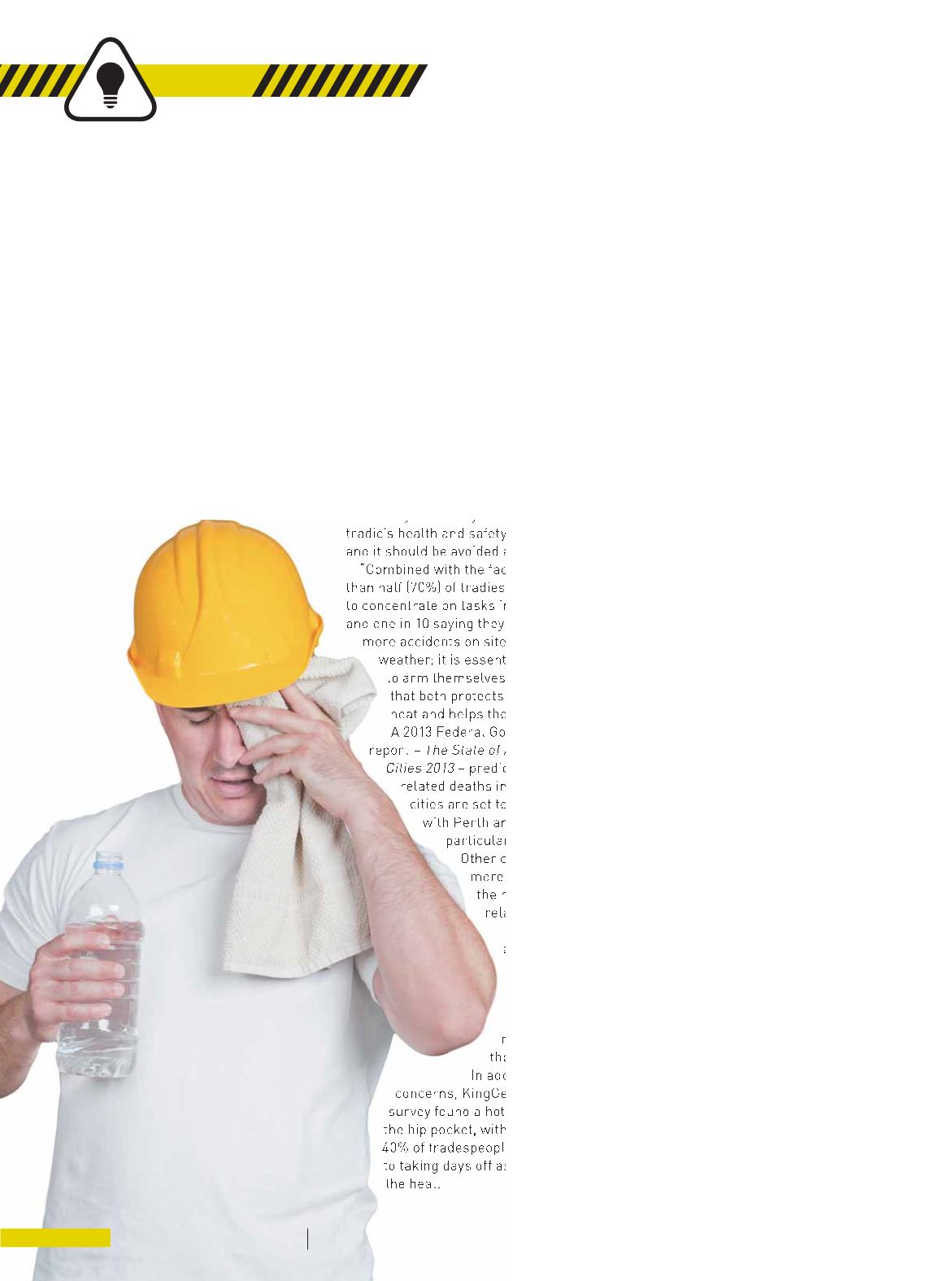

TIPS
T
he Australian summer - now
just months away - takes its toll
on both the health and finances
of our tradie workforce, with one in
10 struck down by heat stroke during
the course of a sticky summer’s day
on the job, according to KingGee’s
Workcool survey.
“Tradies are definitely hit the hardest
by the Australian summer, having to
undertake extreme physical activity
under scorching temperatures,”
KingGee marketing manager Nadia
Zaffino says.
“And, while the trademark tradie
with his shirt off may be a sight for sore
eyes to onlookers, working shirtless
is actually extremely dangerous to a
tradie’s health and safety on the job,
and it should be avoided at all costs.
“Combined with the fact that more
than half (70%) of tradies find it harder
to concentrate on tasks in the heat,
and one in 10 saying they’ve witnessed
more accidents on site during hot
weather; it is essential for tradies
to arm themselves with clothing
that both protects them from the
heat and helps them perform.”
A 2013 Federal Government
report
– The State of Australian
Cities 2013
– predicts that heat-
related deaths in Australian
cities are set to quadruple,
with Perth and Brisbane
particularly affected.
Other cities will see
more than double
the number of heat
related deaths.
“Heatwaves
are the leading
cause of
fatalities
from natural
disasters in
major cities,”
the report says.
In addition to health
concerns, KingGee’s Workcool
survey found a hot day also hits
the hip pocket, with just over
40% of tradespeople admitting
to taking days off as a result of
the heat.
Tradies say they are susceptible to a
number of health issues when working
in the sun all day. One in 10 have been
diagnosed with heat stroke and nearly
half have suffered through a sweaty
summer day to end up feeling weakened
(47%) and/or dizzy (44%). One in three
are hit with nausea (29%).
Employers and workers need to
take extra care during the summer
months to avoid the risk of heat stress
or the more serious heat stroke,
says WorkSafe WA commissioner
Lex McCulloch.
“Workplace safety laws require
an employer to provide a working
environment in which workers are
not exposed to hazards and this
includes, as far as is practicable,
protecting employees from extremes in
temperature,” he says.
“The increased sweating caused by
heat depletes the body’s fluids and can
lead to tiredness, irritability, inattention
and muscular cramps – these are the
symptoms of heat stress.
“Apart from the obvious physical
discomfort of these symptoms, they
may also increase the risk of workplace
injuries by taking a worker’s attention
away from the task at hand, and this is a
major concern.”
The acting general manager of
WorkCover NSW’s Work Health and
Safety Division, Peter Dunphy, says,
“In the three years to July 2011, there
were 497 claims (in NSW) for workplace
fatigue and heat stroke at a cost of $4.3
million, so it needs to be taken seriously
and managed effectively.”
This is just one reason, he says,
workers and businesses need to work in
partnership to protect themselves from
the effects of working in heat.
“If possible, businesses should try
to re-schedule work to cooler times
of the day such as early morning or
late afternoon. If this is not possible,
ensure workers have access to plain
drinking water, at least 200mL every
15-20 minutes, shaded rest areas and
frequent rest breaks.
HANDLING THE HEAT
Australia is known for its extreme heat in summer months,
but there are a few tips to know to avoid becoming a casualty of
heat-related illnesses.
Paul Skelton
reports.
8 6
E L E C T R I C A L CO N N E C T I O N
S P R I N G 2 0 15
















